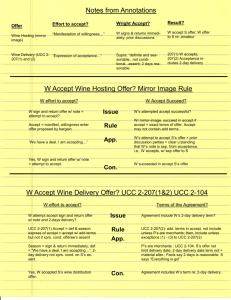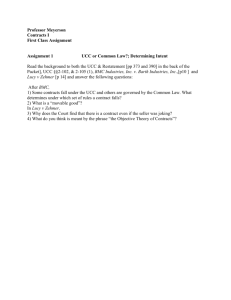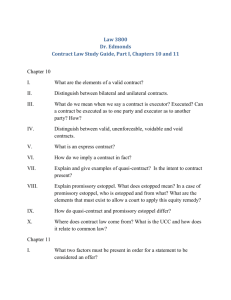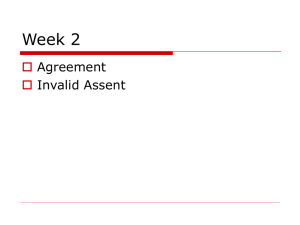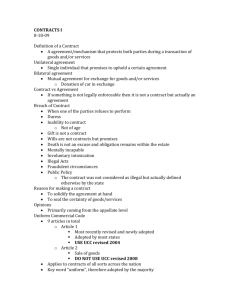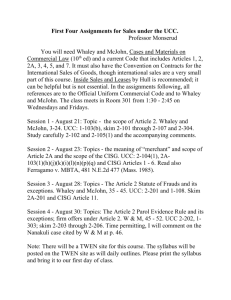Mirror Image Rule
advertisement
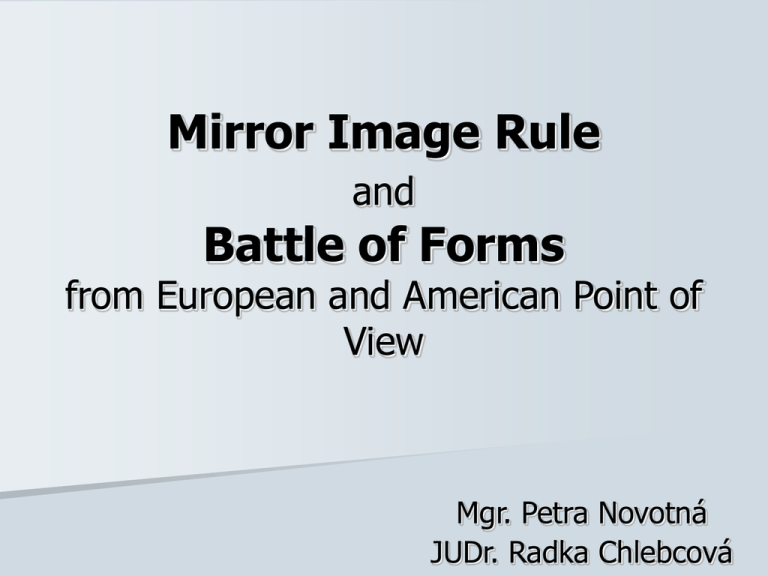
Mirror Image Rule and Battle of Forms from European and American Point of View Mgr. Petra Novotná JUDr. Radka Chlebcová Acceptance with modification (Art. 19 CISG) Acceptance with modification (Art. 19) Exchange of forms containing additional or conflicting terms (no special regulation in CISG) - Battle of the forms Two questions appear when a dispute has arisen: – Was a valid contract formed? – What are the terms of the contract? Mirror image Rule An acceptance must coincide with each and every term of an offer in order to conclude a contract, the acceptance must be the very reflection of the offer in a mirror. Additional or different terms in acceptance (that substantially alters it) = counteroffer Exception: New terms into the acceptance that do not materially (substantially) alter the offer. Material v. Immaterial modifications Material: price; payment; quality and quantity of the goods; place and time of delivery; settlement of disputes. However, notwithstanding paragraph one decision has stated that modifications of matters listed in that paragraph are not material if the modifications are not considered material by the parties or in the light of usages. Immaterial: a reply that modified an offer by stating that the price would be modified by increases as well as decreases in the market price and deferring delivery of one item; seller's standard term reserving the right to change the date of delivery;[12] a request that buyer draft formal termination agreement; a request to treat the contract confidential until the parties make a joint public announcement; contractual requirement that buyer must reject goods delivered within stated period. Battle of the forms A situation in which the parties exchange general conditions, usually preprinted forms prepared by one of the parties or its trade association, that often add one or more terms that materially modify the offer. Three possible solutions: – Formation of contract is issue of validity = excluded from the scope of CISG (Art. 4) – Creates a gap that the court can fill by recourse to Art. 7 (1) = principle of good faith and the application of knock out rule. – Formation of contract is issue similar to the negotiating process (offer and acceptance containing new terms) = In conformity with Art. 19 and the application of last shot rule. (compare par. 2. 4. of Conveyor band case) Different approaches Knock out rule = after the contract was performed, ignoring of conflicting terms and their replacing Last shot rule = each new offer creates a counter-offer until the last one is accepted when one party indicates assent by performance or other conduct, incorporation of terms of last communication. (compare par. 3. 1. of Conveyor band case) Comments on the Brown Machine case What was an offer? Was the acceptation expressly made conditional upon the offerent’s assent? § 2-207 UCC contains the main rule. Hercules purchase order expressly limited acceptance only to these terms. Response from Hercules form Feb. 9/76 stipulated a “general assent with the specifications of the acknowledgment order” § 2-207 UCC Comments The aim of this article: To stipulate rules of offer and acceptance To improve the strict mirror image rule, acceptance even though it states additional or different terms from those offered. To regulate a situation, when the parties assert that a contract exist, but they are in dispute as concerns the terms of the contract. Instruction for applications of § 2207 UCC 1. Finding the first offer – examine the communication between the parties, language of the seller’s form, need for future acceptance of the terms. In some cases: All facts and circumstances including the trade usages, court of dealing between the parties. 2. Testing the response: Applying the test of § 2207 UCC to the purchase order and acknowledgment order. Each of the parties prefers to use its own forms – the process of the contract formation is even more difficult. Instruction for applications of § 2207 UCC 3. Acceptance contains additional terms, but is not expressly conditional – Par. 2 of § 2-207. – Question: Has the other party agree with the additional terms? Without requirement of the accepting party? Y/N, in our case No. The mere use of forms (even if repeated) implies nothing about the awareness of their content, because such forms are never read! Express assent can not be assumed by silence or mere failure to object. Instruction for applications of § 2207 UCC 4. Do the additional terms become a part of a contact anyway? § 2-207 is applicable only if both of the parties are merchants! Possible, – – – if the offer was not restricted only to this terms the additional terms do not materially alters the contract have not been objected Instruction for applications of § 2207 UCC 5. Can agreement with the additional terms be found in the subsequent conduct? To find the assent to a counter-offer in mere performance is to continue in effect the commons law’s “last shot” approach. The aim of § 2-207 UCC was to abrogate “last shot” rule. Policy of the Code requires “specific and doubtless expression of an assent”. Therefore, NOT the MERE performance, but the THEIR ACTION (shipment and receipt of the goods) may establish a contractual relationship under the § 2-207 UCC. Instruction for applications of § 2207 UCC 6. What are supplementary terms under § 2-207 par. 3 UCC? A written contract does not exist, but the parties have performed. The conduct on its own is an evidence of a (oral) contract. The contend of a contract is created by the terms on which the parties had agreed on in their writings and supplementary terms = implied terms (such as implied warranties, damages provisions, liability for damages, course of performance, course of dealing, usages of trade).
